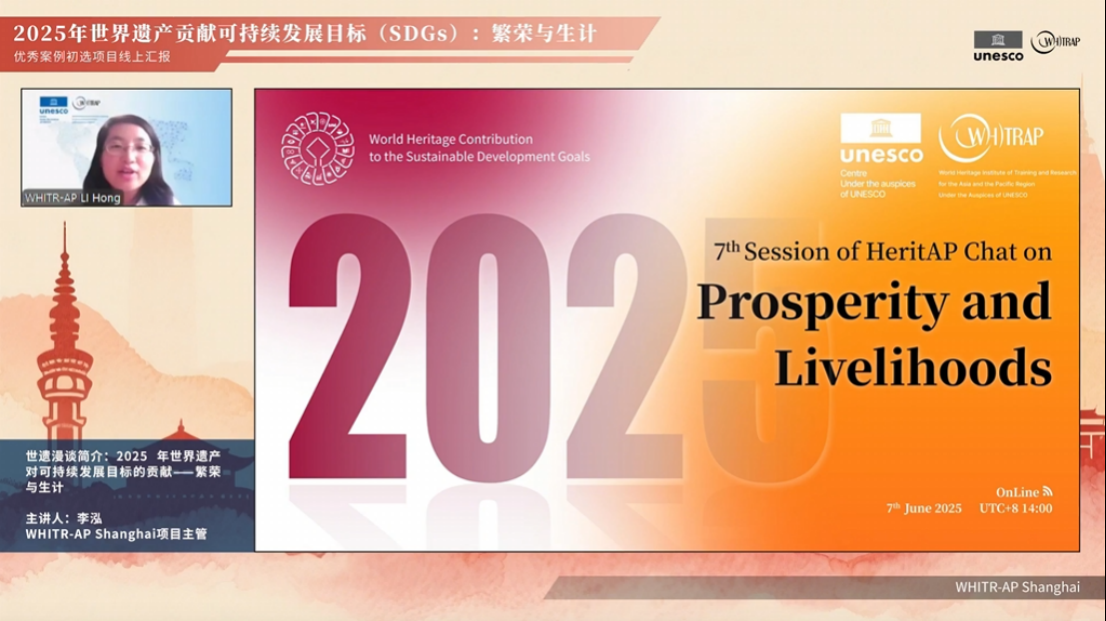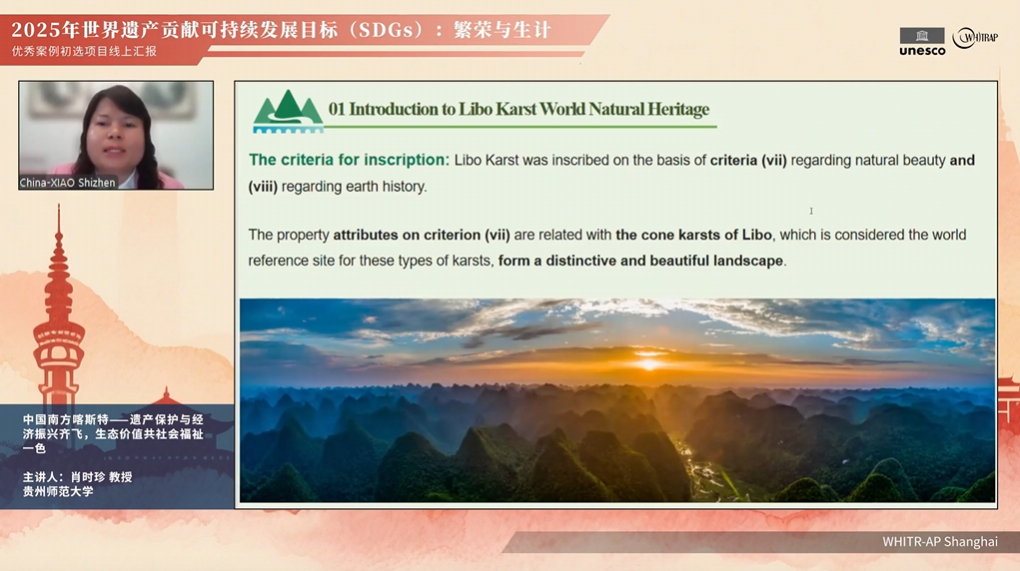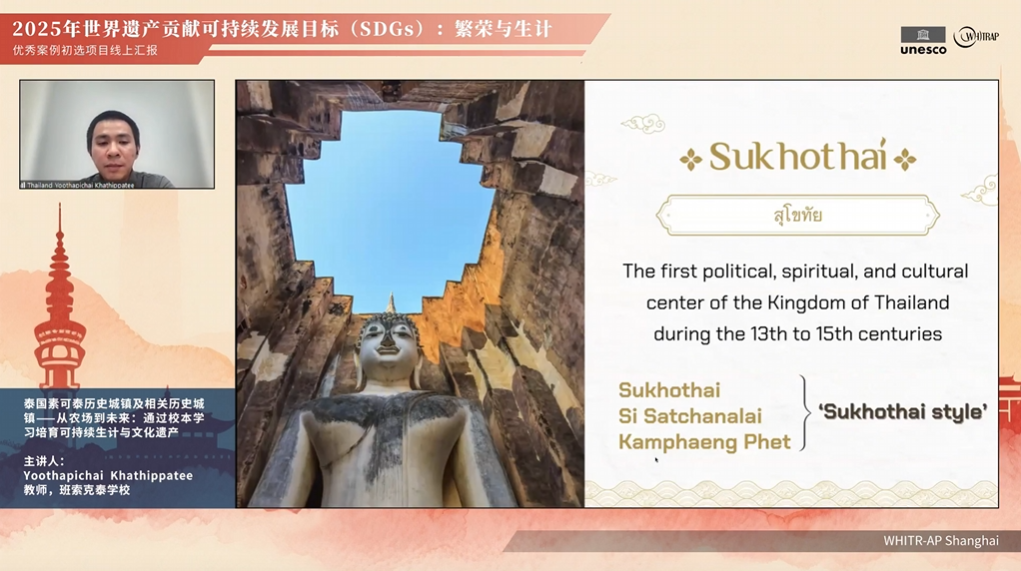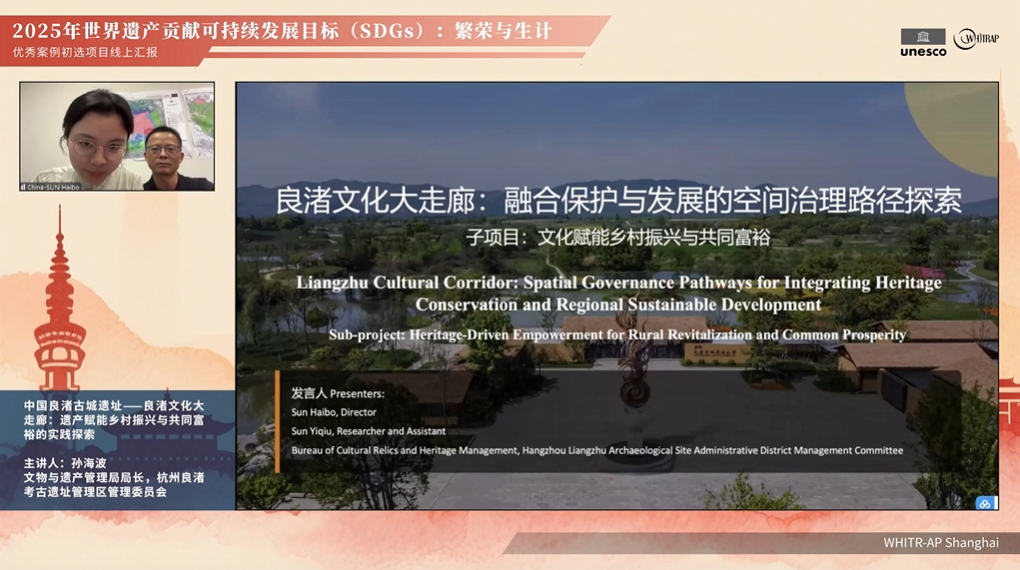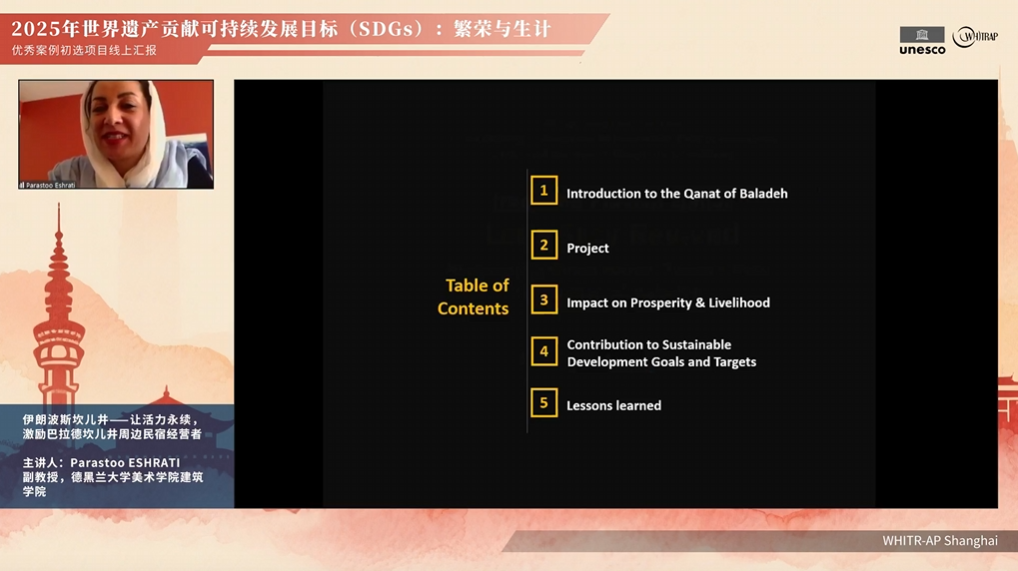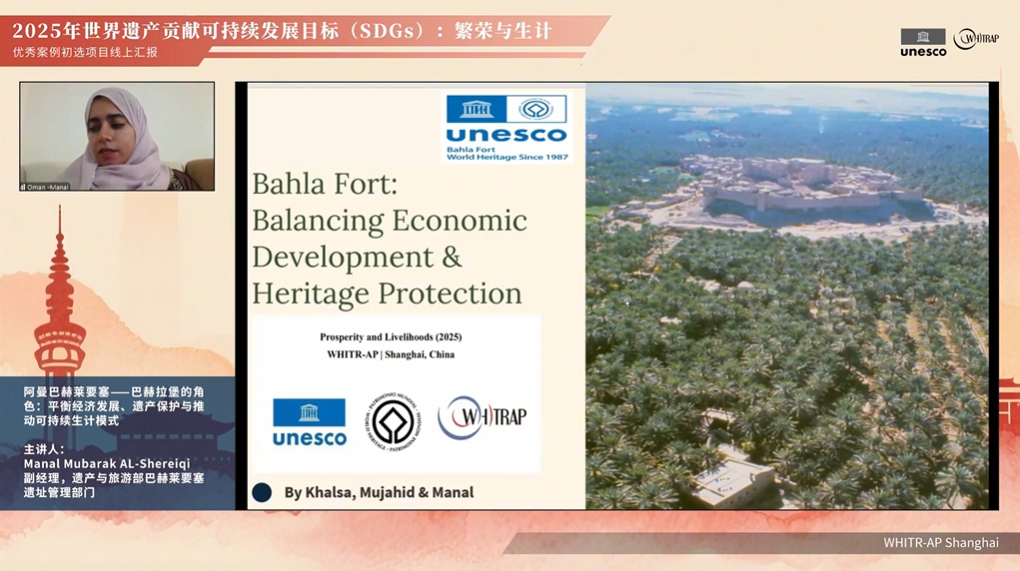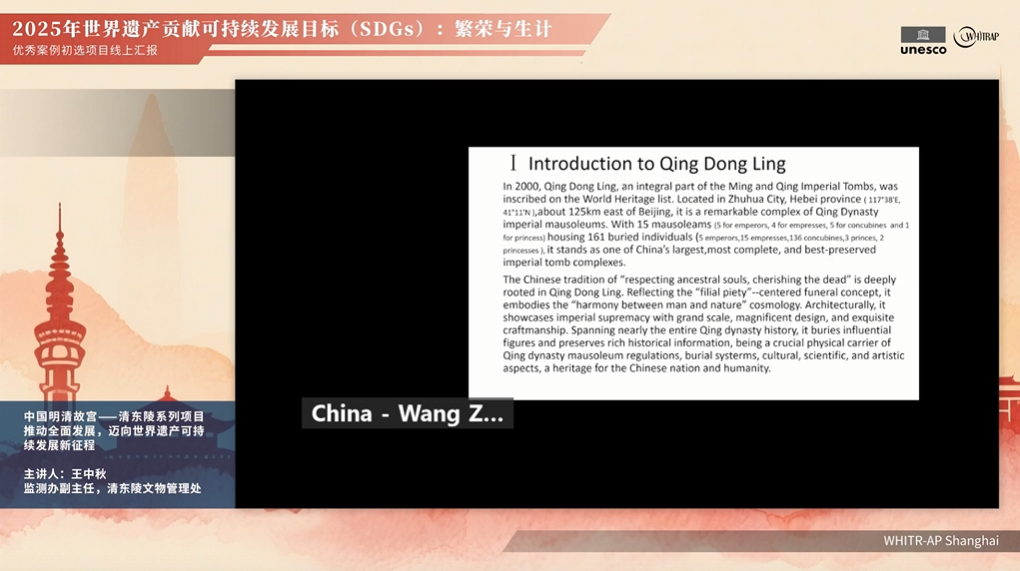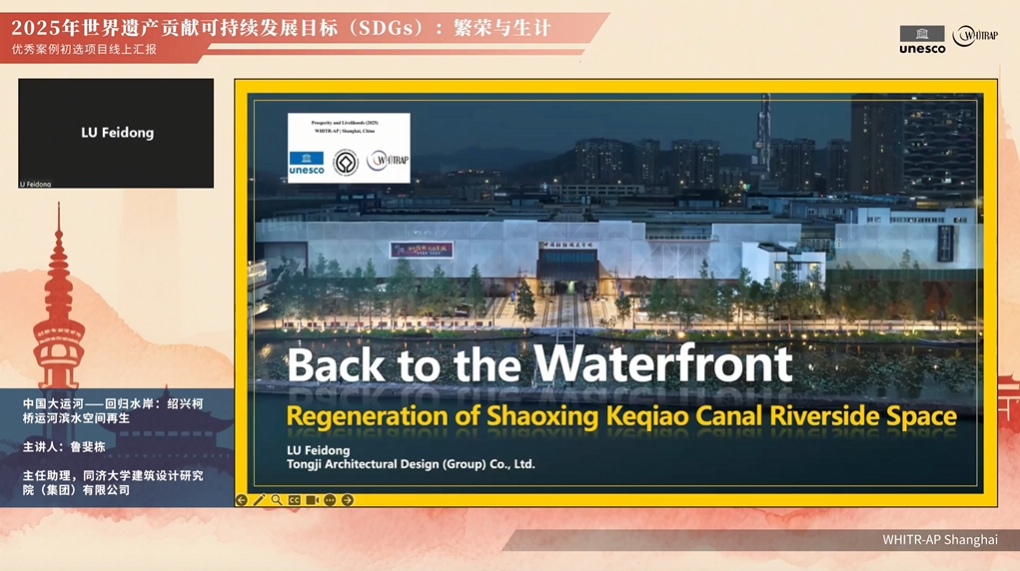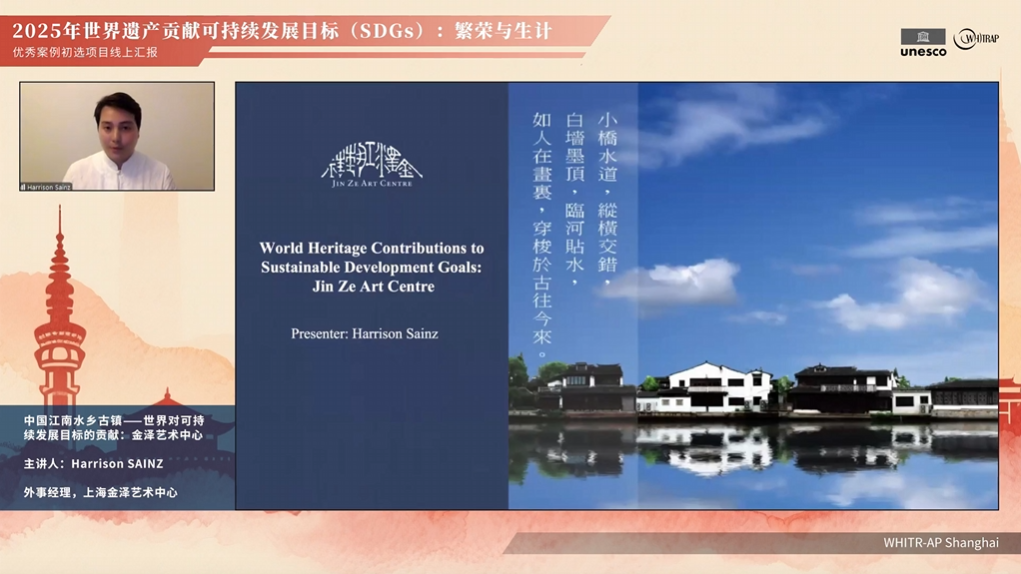| News | World Heritage Dialogue: Online Presentation of Preliminary Selection Projects for 2025 "Prosperity and Livelihood" Outstanding Practices Successfully Convened |
| PublishDate:2025-06-16 Hits:37 |
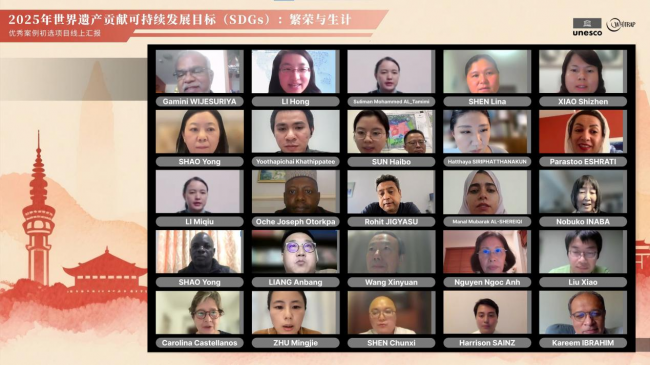 Online group photo of participants
On June 7, 2025, the online presentation for the preliminary selection of outstanding cases for World Heritage Dialogue: 2025 World Heritage Contribution to Sustainable Development Goals: Prosperity and Livelihood was successfully convened. This event was organized by the UNESCO WHITR-AP Shanghai, with the participation of eight expert judges, including WHITR-AP Shanghai Special Advisor Gamini Wijesuriya, WHITR-AP Shanghai Director Shao Yong, SEAMEO SPAFA Senior Specialist in Cultural Heritage Conservation Hatthaya SIRIPHATTHANAKUN, ICCROM Project Manager Rohit JIGYASU, Emeritus Professor of World Heritage Studies at the Graduate School of Comprehensive Human Sciences, University of Tsukuba Nobuko INABA, Deputy Director Wang Xinyuan of the International Centre on Space Technologies for Natural and Cultural Heritage(Hist) under the auspices of UNESCO, and WHITR-AP Shanghai Research Director Carolina CASTELLANOS. Representatives from 18 heritage sites across nine countries (Yemen, China, Thailand, Iran, Nigeria, Oman, Kenya, Vietnam, and Egypt) presented their respective cases. A total of 28 HeritAP members participated in the Zoom meeting, with the live broadcast attracting about 3,100 viewers.
Li Hong, Project Director of WHITR-AP Shanghai, giving the introduction
Ms. Li Hong, Project Director of WHITR-AP Shanghai, noted that this event is an important part of the WHITR-AP Shanghai's six-year project World Heritage Contributes to the Sustainable Development Goals (2023-2028). The project aims to promote understanding of the 2015 UNESCO Policy document for the Integration of a Sustainable Development Perspective into the Process of the World Heritage Convention and create appropriate tools for heritage site managers to identify the ways to achieve sustainable development in heritage conservation and management practices. It will finally form the report World Heritage Contributes to the Sustainable Development Goals: Ways to achieve sustainable development in heritage conservation and management practices. The event seeks to examine the practical implementation of heritage conservation projects and promote the innovative practices of World Heritage in the context of the Sustainable Development Goals to a wider audience. The 2025 call for outstanding practices under the theme Prosperity and Livelihoods will focus on cases shared by 18 heritage sites from 9 countries.The selected cases will be invited to present at the HeritAP Annual Meeting, where their results will be further disseminated.
South China Karst—Heritage Conservation Flies alongside Economic Revitalization, Ecological Values Harmonize with Social Benefits
Introduction by Professor Xiao Shizhen, Guizhou Normal University
The case focuses on the Libo site in Guizhou, part of the World Heritage Property of South China Karst, and explores strategies for promoting sustainable development through cultural heritage preservation and tourism development. Taking Yaoshan as an example, it shows how to use the World Heritage brand effect to enhance international influence, transform ecological value into economic competitiveness,address the livelihood challenges of local communities, and foster localprosperity. Through the protection and sustainable use of World Heritage, the project has promoted a green economy and achieved high-quality economic, social, and environmental development.
South China Karst—Practice of Culture and Tourism Integration in Wulong District, China
Yang Zhao, Deputy Director
World Natural Heritage Conservation Centre, Wulong District, Chongqing, China, and Shen Lina, Assistant Researcher at the Institute of Karst Geology, Chinese Academy of Geological Sciences, giving an introduction
This case focuses on the integrated development of culture and tourism in Wulong District. It emphasizes the region's unique natural landforms and cultural resources, including the Wulong Karst sinkhole complex, which forms part of the World Heritage Property of South China Karst inscribed on the World Heritage List, as well as the challenges the region faces in ecological conservation and economic development. The "Wulong Model" was then introduced—a development approach that integrates culture and tourism, achieving ecological protection, economic growth, and socially inclusive development through scientific planning and conservation management. This model includes training local residents to promote the diversity of ecological industries, as well as combining education with tourism innovation to enhance cultural confidence and participation among rural communities. Additionally, through brand building and international promotion, Wulong has strengthened its status as a world-class tourist destination. Ultimately, Wulong has achieved a balanced development of ecological protection, economic growth and social well-being, providing a Chinese solution for the protection and sustainable use of World Heritage.
Thailand: Historic Town of Sukhothai and Associated Historic Towns—From Farm to Future: Cultivating Sustainable Livelihoods and Cultural Heritage through School-Based Learning
Introduction by Yoothapichai Khathippatee, Teacher at Bansokthai School
The project focuses on the historical town of Sukhothai and related historical towns in Thailand. It has significantly enhanced students' overall competence and promoted the sustainable development of the local community by combining practical learning with cultural and economic development. The program not only improved students' academic performance and household income, but also strengthened their agricultural knowledge, financial management skills and cultural identity.Through participation in activities such as organic farming, youth entrepreneurship, and traditional cultural performances, students’ incomes increased by about 30% and the use of chemical pesticides was reduced by about 60%. In addition, around 50% of students took part in traditional Thai dance and music performances, bringing extra income to the community and reinforcing cultural transmission. The project also supports multiple Sustainable Development Goals, including Zero Hunger, Quality Education, Decent Work and Economic Growth, Responsible Consumption and Production, Climate Action, and Life on Land, thereby creating a learning cycle where knowledge, culture, and livelihoods support each other. By incorporating sustainability principles and hands-on learning, the project has successfully transformed students, schools, and communities, demonstrating a model in which rural education and sustainable development mutually strengthen each other. Furthermore, the success of the project underscores the importance of intergenerational knowledge exchange and community participation, , building a holistic ecosystem that integrates culture, education, and economic development through collaboration with parents and local institutions.
China: Archaeological Ruins of Liangzhu City—The Liangzhu Cultural Corridor: Heritage-Led Prosperity and Innovative
Sun Haibo, Director of the Bureau of Cultural Relics and Heritage Management of the Hangzhou Liangzhu Archaeological Site Administrative District Management Committee, and Sun Yiqiu giving a joint introduction
The case focuses on the Liangzhu Cultural Corridor project, initiated by Yuhang District with support from provincial and municipal authorities.The project integrates cultural heritage protection, ecological conservation, spatial planning and community participation, covering both core and key development areas. It has created a coherent cultural landscape by connecting heritage sites, historical continuity, and cultural industry development. Rural revitalization serves as a key pillar, showcasing how heritage can contribute to equitable development. The project encompasses the Liangzhu site, sections of the Grand Canal, and multiple forms of intangible cultural heritage, providing a foundation for governance and development strategies. Through a model combining government leadership, community coordination, platform implementation, and community participation, it has transformed protection from a fragmented approach into systematic governance. A spatial compensation mechanism allocates land quotas to villages restricted by heritage protection, in exchange for development rights in designated zones, thereby ensuring both stable economic growth of villages and the protection of cultural heritage. In addition, the project has achieved remarkable outcomes in cultural engagement, public awareness, and implementation, including hosting traveling exhibitions, attracting a large number of visitors, and drawing cultural enterprises as well as high-calibre cultural professionals.
Iran: The Persian Qanat—Let's Stay Revived (Motivating Guesthouse Owners Near the Qanat of Baladeh)Introduction by Parastoo ESHRATI, Associate Professor at the School of Architecture, College of Fine Arts, University of Tehran
The case focuses on homestay operators around the Persian Qanat in Iran.The project aims to motivate guesthouse owners near the area to continue operating to promote the cultural heritage values at both the local and global levels. Since November 2020, the project has supported traditional guesthouse owners in sustaining their businesses in response to post-pandemic challenges. However, due to its remote location and absence from Iran's main tourist routes, the region is relatively unknown to both international and domestic tourists, posing significant challenges for tourism attraction. The case seeks to raise awareness of cultural heritage through social media platforms such as Instagram, and through collaboration with different institutions and personnel, especially with hostel hosts and the University of Tehran.
The project has undertaken actions including capacity improvement, strategic planning and monitoring, resulting in increased local employment and higher guesthouse booking rates. In addition, it has focused on resource development to support economic, social, cultural and environmental sustainability, while promoting community development by training local residents in hospitality and social media skills. These efforts have not only contributed to the preservation of cultural heritage but also enhanced the economic vitality of local communities through sustainable tourism development.
Oman: Bahla Fort—Bahla Fort's Role: Balancing Economic Development, Heritage Protection, and Promoting a Sustainable Introduction by Manal Mubarak AL-Shereiqi, Deputy Manager of Bahla Fort Site Department, Ministry of Heritage and Tourism
The case focuses on the protection and restoration of Bahla Fort, a cultural heritage site in a semi-arid region, which was inscribed on the World Heritage List in 1987 and is valued for its unique architectural and cultural significance. The site comprises the core area, the surrounding defensive walls, and important buildings such as the historic Friday Mosque. Due to environmental challenges such as drought and fluctuations in rainfall, these structures face erosion risks. To address these issues, the government launched and implemented a 20-year restoration programme. The presentation also emphasized the importance of digital documentation in the protection, planning and promotion of the site, and highlighted how cooperation with the tourism department and other stakeholders has jointly promoted its management and conservation.
Nigeria: Sukur Cultural Landscape—Sustainable Heritage-Based Livelihoods and Environmental Conservation at Sukur World Heritage SiteIntroduction by Oche Joseph OTORKPA, Lead Consultant of the Advocacy for Public Health Care and Hygiene Foundation
The site was inscribed on the UNESCO World Heritage List due to its unique iron-smelting and agricultural traditions, and it is also the first site in sub-Saharan Africa to receive this designation. The project aims to achieve the protection of cultural heritage and the sustainable development of local communities by reviving traditional iron-smelting and agricultural practices, promoting community-led ecotourism, and strengthening traditional governance structures. Despite the threat of terrorism in the region, the project draws upon its rich cultural heritage and unique natural environment to provide an important foundation for future implementation.
China: Cultural Landscape of Honghe Hani Rice Terraces—The Prosperity and Livelihood of Azheke Village: A Case Study on the Protection, Development and Inheritance of Honghe Hani Rice Terraces Cultural Landscape
Introduction by Li Miqiu, Director of office
Administration of Hani Rice Terraces
This case focuses on the prosperity and livelihood of Azheke Village, part of the Honghe Hani Rice Terraces Cultural Landscape in China. Economic development in Azheke has been slow, constrained by its relatively isolated location and a traditional but inefficient rice cultivation model. With half of the village's labour force working outside, the World Heritage designation has provided a new starting point for protection and development of the village. On the basis of heritage protection, the architectural planning was tailored to the needs of the village, introducing a long-term incentive and subsidy mechanism for the protection of traditional houses as well as for daily village maintenance. The heritage area has improved the living environment, with more than 4,000 traditional houses restored in total, alongside a centralized restoration program and the National Traditional Village Protection List initiative, helping to maintain the style and character of villages like Azheke.
China: Imperial Tombs of the Ming and Qing Dynasties—Qing Dong Ling Series Projects Promote Comprehensive Development - Marching Towards a New Journey of Sustainable Development of World Heritage
Introduction by Wang Zhongqiu, Deputy Director of Heritage Monitoring Office, Qing Dong Ling Cultural Relics Management Office
The case focuses on the Qing Dong Ling series project in China, which centres on the sustainable development and protection of the Ming and Qing imperial tombs. A key emphasis is placed on returning benefits to local villagers, thereby encouraging them to safeguard cultural heritage while improving their quality of life. From the perspective of the Qing Dong Ling, the project highlights the comprehensive and sustainable development of the Ming and Qing imperial tombs as a World Heritage property, including their historical value, protection and management requirements, and restoration efforts through the combination of traditional craftsmanship and modern technology. The discussion also addressed the architecture and layout of the tombs, as well as the challenge of balancing heritage conservation with tourism and urban development.
China: The Grand Canal—Back to the Waterfront: Regeneration of Shaoxing Keqiao Canal Riverside Space
Introduction by Lu Feidong, Deputy Director of Tongji University Architectural Design(Group) Co., Ltd.
The case focuses on the Shaoxing section of China's Grand Canal, aiming to restore and enhance the Grand Canal's heritage, address water pollution, improve the ecological environment, and achieve green and clean water by improving the sewage treatment system. In addition, the project employs digital technology to optimize space use, remove high walls, and improve bridge connections, thereby enhancing connectivity between the two banks and public accessibility. It also demonstrates how traditional elements can be incorporated into architectural design through AI-assisted design and the participation of local children, showcasing architectural styles and improving the city's image and quality of life through the renewal of bridges and buildings.
China: The Grand Canal—The Revitalization Practice of Historical City in the Post Grand Canal Economic Era of China This case focuses on the Grand Canal in China, taking the urban renewal project in the Yuyuan Block of Guangling District, Yangzhou as an example. The Grand Canal is introduced as the world's longest and oldest artificial waterway, with Yangzhou playing a leading role in its inscription as a World Heritage site. The geographical location, historical buildings, and cultural heritage of the Yuyuan neighborhood, together with the project's expected timeline from 2018 to 2028, were described in detail. By integrating construction, investment and operation, the project adopts innovative strategies for protection and regeneration to promote the inheritance and innovation of cultural heritage. In addition, it has been recognized and funded by the central government and is expected to further enhance the cultural vitality and quality of life in the region, encourage population return, and further develop and pass on the tangible and intangible cultural heritage associated with the canal culture. This case demonstrates the government's commitment and outcomes in the revitalization of historic cities, as well as the confidence and momentum generated by the project’s strong return on investment.
China: Wulingyuan Scenic and Historic Interest Area—Living Symbiosis between Natural Heritage and Local Rural Residents - Strategic Planning and Village Design for Rural Revitalisation in Wulingyuan DistrictIntroduction by Qiao Lu, Senior Engineer of Shanghai Tongji Urban Planning and Design Institute Co., Ltd.
The case focuses on the Wulingyuan Scenic and Historic Interest Area in Hunan Province, China, a World Natural Heritage site renowned for its magnificent mountains and sandstone pillars. However, tourism development has impacted the local ecosystem and residents' lives, posing a dilemma between heritage conservation and economic development. The project focuses on local villagers, emphasizing their unique agricultural practices and landscape wisdom shaped by long-term interaction with nature and adapted to ecological conditions.
Launched in 2018 as part of conservation planning for the natural heritage site, the project aims to guide rural residents to more sustainable lifestyles by drawing upon their agricultural knowledge. The project uses digital technology to assess linkages between villages, the heritage site, nearby towns, and other settlements to develop differentiated development strategies. For villages closely connected with the natural heritage site, the project prioritizes rebuilding ecological habitat networks, restoring artificial waterfronts, and preserving biological habitats to promote the coordinated development of ecology and tourism. In areas with stable agriculture, it uses the villagers' continuous agricultural activities as tourism resources to enhance economic value. At the same time, the project redesigns villages closely linked to towns to improve disordered environments and enhance the overall visitor experience. Through these measures, the project seeks to achieve rural prosperity, improve the living standards of residents, and ensure the stability of basic income.
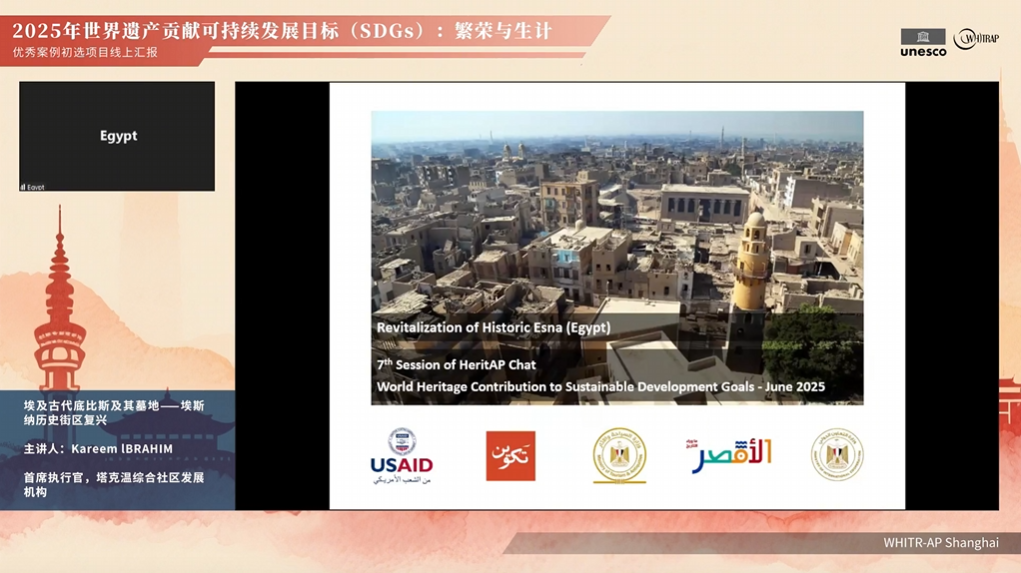 Egypt: Ancient Thebes with its Necropolis—Revitalization of Historic Esna
Introduction by Kareem IBRAHIM, CEO of the Takween Integrated Community Development Agency
The case focuses on the Esna Historic District in Egypt, with the aim of improving site accessibility, especially for the elderly and foreign tourists, in order to enhance the tourism experience and preserve the cultural heritage. The project not only restored a subterranean ancient temple but also added facilities such as elevators and improved stairways. In addition, it has restored and upgraded markets and key community buildings, including mud-brick buildings, traditional craftsmanship, and wooden doors. At the same time, it has stimulated the local economy by upgrading hotels and promoting local cuisine and crafts. These initiatives have not only improved the visitor experience but also generated economic benefits for the local community.
China: The Ancient Waterfront Towns in the South of Yangtze River—The Exploration of Heritage Value and the Practice of Local Regeneration in Jiaoxi Ancient Town
Introduction by Zhu Mingjie, Head of Industrial Design Department, Shanghai University of Engineering Science, and Chief Designer, Jiaoxi Community Lab
This case focuses on Jiaoxi Ancient Town, one of the historic water towns in the Jiangnan region of China. Since 2019, Jiaoxi Ancient Town, as a candidate site for World Cultural Heritage inscription, has continued cultural heritage protection and restoration. In this process, the local community has cooperated with residents to carry out in-depth community construction and local revitalization from seven aspects, including the investigation of heritage elements, daily community activities, and jointly envisioning the future with local residents. By investigating history, cultural traditions, holding traditional events, and using new media for promotion, the project has attracted greater attention and commercial return, prompting younger generations to return to the community. These efforts have led to environmental improvements, the preservation of buildings, and the restoration of community vitality, demonstrating the positive interaction between cultural heritage protection and community development.
China: Classical Gardens of Suzhou—Adaptive Use of Heritage and Sustainable Development in Tongli Ancient Township
Introduction by Shen Chunxi, Director of the Construction Management Office of the People's Government of Tongli Town, Wujiang District, Suzhou
The case focuses on the ancient town of Tongli, part of the Classical Gardens of Suzhou World Heritage property, which has continued to develop since its establishment in the Song Dynasty. The ancient town revolves around five lakes and connects seven islands through forty-nine bridges, preserving the traditional layout of streets built along the waterways. Tongli Ancient Town has implemented systematic protection and development measures, including the restoration of streets and ancient bridges, water purification projects, and the protection and restoration of historic buildings, the modernization of public facilities (such as improvements in transportation, fire protection, and power systems), and the construction of community service centers, schools and kindergartens, thereby improving the life's quality of residents. Through these efforts, the tourism industry in Tongli Ancient Town has developed rapidly, with significant growth in annual tourist numbers and tourism revenue, as well as increased local employment and higher household income. These achievements reflect the successful practice of Tongli Ancient Town in cultural heritage protection and sustainable development.
China: The Ancient Waterfront Towns in the South of Yangtze River—World Contributions to Sustainable Development Goals: Jin Ze Art Centre
Introduction by Harrison SAINZ, Foreign Affairs Manager of Shanghai Jin Ze Art Center
The case focuses on the Jin Ze Art Center, which aims to protect and transmit traditional Chinese culture by renovating abandoned factories to support and cultivate traditional skills such as mineral painting, textiles, and embroidery. The center not only provides education and skills training, but also pays attention to the health and well-being of students, conducting regular physical examinations and treatments. Especially during the epidemic, it took measures to prevent infection and provide the necessary livelihood support. Since 2002, the center has supported more than 1,000 artisans and has made a breakthrough in gender equality, with female students accounting for a significant proportion in learning traditional skills. At the same time, the center collaborates with Nanjing University of Traditional Chinese Medicine to promote a healthy lifestyle, emphasizing educational equity and the enhancement of cultural values.
Viet Nam: Ha Long Bay - Cat Ba Archipelago in Vietnam—Collaborative Climate Education through Bilingual Storytelling by English Teachers and Quang Ninh Museum Staff: Preserving Ha Long Bay—Cat Ba Archipelago, Vietnam
Introduction by Nguyen Ngoc Anh, Senior Teacher Trainer/Researcher of the Vietnam National Institute of Educational Sciences
The case focuses on the Ha Long Bay—Cat Ba Archipelago in Vietnam, aiming to promote cultural heritage conservation and climate change education through the collaboration of English teachers and museum staff. The project focuses on increasing students' awareness of the environment and heritage, enhancing their bilingual storytelling skills, and integrating museum artifacts into curriculum design. The project aligns with UNESCO's priorities and the Sustainable Development Goals (SDGs), including education for sustainable development, cultural heritage preservation, and climate action. The project was implemented in close collaboration with local education departments, museums, environmental experts and partners such as UNESCO. It also emphasizes the central role of teachers, using online training, museum visits, curriculum design, and activity implementation to engage students in practical actions to protect local environments and cultural heritage through the design and implementation of bilingual curricula related to climate change.
Kenya: Sacred Mijikenda Kaya Forests—Utilization of Indigenous Luo Masonry in the Restoration of Fallen Walls of Thim Lich Ohinga UNESCO-World Heritage Site
Introduction by JULIAS JUMA OGEGA, Keeper of Antiquities, Sites and Monuments in the Western Region of the National Museum of Kenya
The case focuses on the archaeological site of the Thim lich Ohinga settlement in Kenya. The project leader described the challenges faced by the site as a manifestation of a unique traditional dry-stone masonry technique, which has been threatened by climate change and the disruption of community knowledge transmission. By working with local communities, the project aims to restore collapsed walls while training young people to inherit building skills that are at risk of being lost, ensuring the long-term preservation of heritage and the sustainable development of the community. Additionally, the project highlights the importance of raising awareness among local populations about the significance of heritage and the preservation of other dry-stone wall sites that are not inscribed on the World Heritage List but also hold cultural value. Ultimately, the project not only has restored the structural stability of the site but also enhanced the community's capacity to protect and manage it, while strengthening the region's status and value as the only World Heritage site in western Kenya. |
- Internship Opportunity | 2026 Spring Internship Recruitment for WHITR-AP Secretariat and WHITR-AP Shanghai
- News | UNESCO Will Release New Cases of the Urban Heritage Atlas
- NEWS | WHITR-AP Participates in UN-Habitat Forum
- Preview | WH Properties Assessment: An Overview Across The World
- Preview | Heritage Educational Landscape Exhibition Opening Soon
- Preview|1st UHC-HEI International Conference to open in Shanghai
Copyright © 2009-2012 World Heritage Institute of Training and Research-Asia and Pacific (shanghai)


